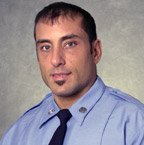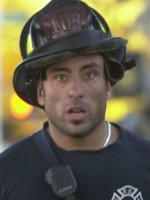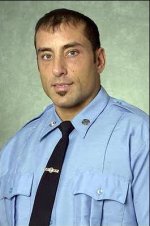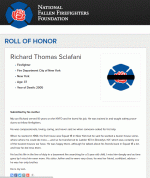NY Times
Harrowing Details of a Firefighter's Death
The death of Firefighter Richard T. Sclafani in an apartment fire in Brooklyn in January came at the end of a day already full of heartache
and disbelief. That morning, in the Bronx, six city firefighters had jumped four stories into a snowy alleyway to escape a rampaging blaze. Two were killed and the others injured, three critically.
The wrenching imagery from the Bronx fire was followed by hard questions: why a hose trained on the fire lost pressure, and whether firefighters would have been able to escape with safety ropes -- equipment that the Fire Department had stopped supplying years before.
The Brooklyn fire, the one that killed Firefighter Sclafani, seemed to be a simpler, if no less sorrowful, episode to sort through. Fire officials speculated that he was snagged by a coat rack as he tried to escape a cellar thick with smoke. He became trapped on a cramped, cluttered staircase that should have been his escape route. Colleagues were unable to drag him to safety in time, and he died of smoke inhalation and third-degree burns.
Together, the two fires produced the worst single-day losses for the Fire Department since 9/11. Still, in the months that followed, Firefighter Sclafani's family could not help feeling that his death had somehow been forgotten. His sister, Joann Sclafani-Asch, 34, said yesterday that although she felt awful about the loss of the other firefighters, "because of all the publicity surrounding the Bronx fire, my brother was just a background story."
But an investigative report on the Brooklyn fire -- released on Wednesday along with a similar report on the Bronx blaze -- tells the story in harrowing detail. It raises questions about procedures and tactics that are just as striking as the ones raised about the fire in the Bronx, and about the training firefighters receive for rescuing colleagues.
Among the report's other findings: a hose became tangled in the clutter on the landing next to Firefighter Sclafani, and sat unused; firefighters clustered together near doorways, blocking access through them; and, as was the case in the Bronx fire, distress calls went unheeded, causing further confusion.
Rescue training was scrutinized after a 1999 house fire that killed a Fire Department captain in Queens. An investigation found that the captain, Vincent Fowler, had failed to leave the burning house as his tank was running out of air. That failure and lapses in discipline by firefighters trying to rescue him prompted the department to release a bulletin outlining rescue procedures.
In the report on the Brooklyn fire, the investigators recommended changes to the bulletin, in particular the designation of a rescuer to make sure that a fallen firefighter gets air.
At a news conference on Wednesday, Peter E. Hayden, the chief of department, said that Firefighter Sclafani had been difficult to move as he lay unconscious in heavy gear and wet clothes. Still, he said, "when we have a firefighter unconscious and down, we have to do a better job of removing him."
The reports into the two Jan. 23 fires highlight the need for regular refresher courses in basic training, said Capt. Peter L. Gorman, the president of the Uniformed Fire Officers Association. "Both these reports are very clear," he said. "They aren't afraid to take a critical look. It's painful, because in the fire service, you make split-second decisions."
Sign up for the New York Today Newsletter Each morning, get the latest on New York businesses, arts, sports, dining, style and more. Get it sent to your inbox.
As it had during the Bronx fire that morning, the weather worked against the firefighters in Brooklyn. By 1:37 p.m., when the call reporting the fire came in, the city was blanketed with more than a foot of snow.
Just minutes after Firefighter Sclafani arrived at the fire, he was on the ground, unconscious, his face mask ripped off.
From the investigators' report, it appears that Firefighter Sclafani, along with another officer from Ladder Company 103 who was not named, headed straight toward the source of the fire, in the cellar of a two-story house at 577 Jerome Street in East New York. The two descended a small staircase, and another firefighter followed with a hose.
Within minutes, the officer with Firefighter Sclafani -- by now unable to see the screen on his thermal imaging camera because of the smoke -- decided that it was time to leave. The two crawled back up the stairs, running into other firefighters who were also trying to exit. The officer later told investigators that he heard Firefighter Sclafani behind him saying in a muffled tone, "Let's go, let's go."
When the officer reached the front stoop, he realized that Firefighter Sclafani had been left behind. He returned to the staircase and found him unconscious, slumped on the stairs, his helmet and facepiece off. Amid high heat and heavy smoke, the report says, two men were unable to move Firefighter Sclafani, and after trying for five or six minutes, they retreated.
In the critical minutes to come, there were other attempts to remove Firefighter Sclafani, all unsuccessful. It was not until 2:10 p.m. -- 22 minutes after the officer first transmitted a distress call -- that a team of firefighters using a rope was able to drag him, face down, up the stairs and away from the fire.
"He was left alone for quite a few minutes," said Ms. Sclafani-Asch, his sister. "I'm not blaming anyone in particular. But why didn't they share their oxygen? Twenty-two minutes is a long time."
It was not clear yesterday why getting air to Firefighter Sclafani had been so difficult, but apart from the recommendations to the Fire Department, the investigators also found numerous lapses by the firefighters that day, including the possibility that a hose fed through another cellar entrance actually intensified the heat around Firefighter Sclafani.
"I said to Richard once, 'If it looks impossible, don't go in,"' his mother, Joan Sclafani, recalled yesterday at her home on Staten Island. "He said, 'Mom, that's what I do."'
He was known as the first man in and the last man out, she said. "And that day he proved it.
The death of Firefighter Richard T. Sclafani in an apartment fire in Brooklyn in January came at the end of a day already full of heartache and disbelief. That morning, in the Bronx, six city firefighters had jumped four stories into a snowy alleyway to escape a rampaging blaze. Two were killed...

www.nytimes.com








